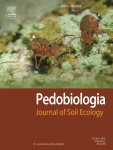Ver ítem
- xmlui.general.dspace_homeCentros Regionales y EEAsCentro Regional Patagonia SurEEA Santa CruzArtículos científicosxmlui.ArtifactBrowser.ItemViewer.trail
- Inicio
- Centros Regionales y EEAs
- Centro Regional Patagonia Sur
- EEA Santa Cruz
- Artículos científicos
- Ver ítem
Mineral fertilization impacts microbial activity and endophytic fungi but not microbial biomass in semiarid grasslands
Resumen
Applications of mineral fertilizer to grasslands have become more frequent in recent decades to increase forage production. However, the impacts of mineral fertilizer on the soil microbiome is poorly understood in cold semiarid grassland ecosystems of Southern Patagonia, Argentina. Therefore, our objective was to analyze experimentally the influence of mineral nutrient fertilization (N, P, K, and NPK in combination) on soil microbial community attributes,
[ver mas...]
Applications of mineral fertilizer to grasslands have become more frequent in recent decades to increase forage production. However, the impacts of mineral fertilizer on the soil microbiome is poorly understood in cold semiarid grassland ecosystems of Southern Patagonia, Argentina. Therefore, our objective was to analyze experimentally the influence of mineral nutrient fertilization (N, P, K, and NPK in combination) on soil microbial community attributes, such as microbial biomass carbon (MBC) and nitrogen (MBN), soil basal respiration (SBR), microbial metabolic coefficients, the colonization of endophytic fungi such as arbuscular mycorrhizal (AM)
fungi, and dark septate endophytes (DSE), and aboveground plant productivity. Mineral fertilization with macronutrients (N, P, K, and NPK) decreased the SBR, qCO2, AM fungi and DSE fungi, but did not generate changes in MBC and MBN. The magnitude of these responses depends on years after fertilization. We found that soil microbiome was strongly dependent on a range of biotic and abiotic factors, such as growing season precipitation, aboveground plant biomass the relationship between the microbial biomass and microbial respiration, and between endophytic fungi and plants. This work improved our understanding of the soil microorganisms’ response to mineral fertilizer application and provides new insights into soil nutrient dynamics and ecosystem
functioning.
[Cerrar]

Fuente
Pedobiologia 102 : 150929 (2024)
Fecha
2024-01
Editorial
Elsevier
ISSN
0031-4056
Formato
pdf
Tipo de documento
artículo
Palabras Claves
Derechos de acceso
Restringido
 Excepto donde se diga explicitamente, este item se publica bajo la siguiente descripción: Creative Commons Attribution-NonCommercial-ShareAlike 2.5 Unported (CC BY-NC-SA 2.5)
Excepto donde se diga explicitamente, este item se publica bajo la siguiente descripción: Creative Commons Attribution-NonCommercial-ShareAlike 2.5 Unported (CC BY-NC-SA 2.5)


